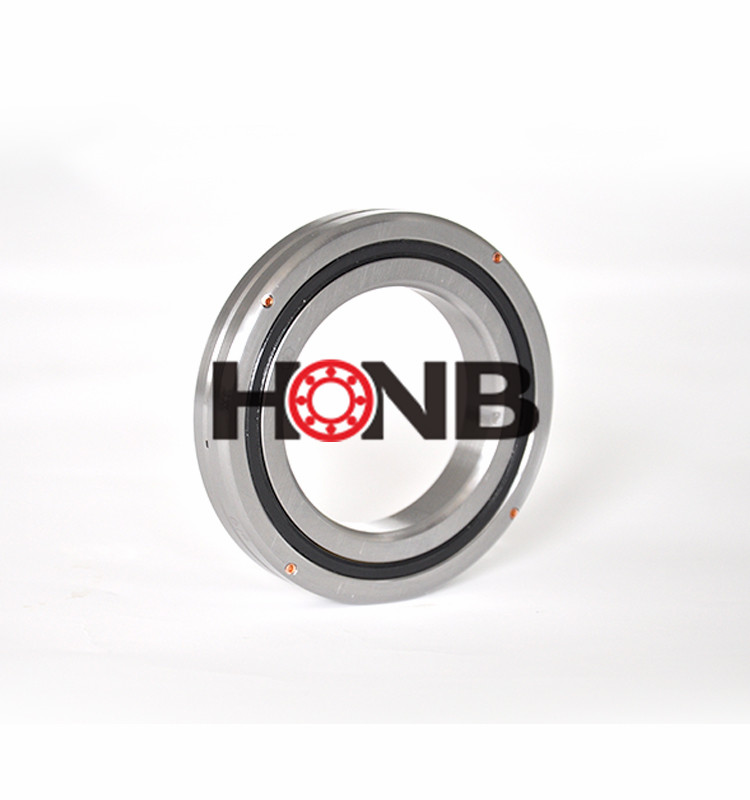1. Magnetic mark condition of bearing outer ring section
1) Appearance check the magnetic mark condition of bearing outer ring section
Magnetic marks on the outer ring of a bearing on the railway are located on the end face of the ring, which are densely distributed along the circumferential direction in a short linear or point-like shape, and the distribution area is about 1/3 of the circumference.
2) Microscopic observation of magnetic marks in section of bearing outer ring
Metallographic samples at magnetic marks on the bearing outer ring end face were prepared, and the samples were slightly ground and observed under a magnifying glass. It could be seen that there were a large number of small pitting defects densely distributed on the bearing outer ring end face. The defect shines under light because its bottom or side wall reflects light. The size of pit defects varies, but it can be roughly seen that the shape distribution direction is along the circumferential direction.
Microscopic observation shows that the tiny defects are holes, which are strip shaped and no inclusion is found inside. The length is about 0.3mm and there is a certain depth.
2. Some common defects on the bearing surface
In the bearing production process, the bearing surface appears similar pit defects, there are the following possible: mechanical injury, corrosion pit, forged overburned hole outcrop and raw material defects. Among them, mechanical damage is caused by the impact or knock on the surface of the parts, corrosion pit is caused by the surface of the parts contact with the corrosive medium caused by pit corrosion marks, these two kinds of defects from the generation mechanism determines that it will not appear in the parts. However, raw material defects are metallurgical defects, and their distribution in the final product parts is relatively irregular. The overburned holes in forging are thermal defects, which are distributed in the parts with serious segregation inside the tissue. These two defects are not confined to the surface of the part.
3. Bearing processing process
As is known to all, in the process of bearing processing, bearing steel only undergoes three high temperature (above 800℃) processing processes: hot rolling forming, forging forming and heat treatment bainite quenching process. Generally speaking, in the three heating processes, the heat treatment quenching heating temperature is lower than the forging temperature and hot rolling temperature. The organization rating of magnetic mark bearing ring is qualified, which proves that there is no overheating in the heat treatment process, so the hole in the bearing ring should not be generated in the heat treatment process.
Too little forging will cause the grain size of bearing steel to grow up. When it is serious, not only the surface metal grain boundary is oxidized and cracked, but also the grain boundary begins to melt in the area with more serious segregation of the metal internal composition, forming sharp angular holes. If too little bearing steel forging leads to holes in the finished ring organization, there are also two cases:
1) Within the temperature range specified in the process, the local tissue on the ring is seriously segregated, resulting in local overburning;
2) The overhigh forging temperature leads to the grain growth of the whole ring, the grain boundary begins to melt, and the formation of holes in the organization.
In the above two cases, grain growth in the area where the hole is located is inevitable, so the observation of the fracture in the burned forging area generally presents sparkling grain edge, which is called stone fracture.
The observation of the fracture of the magnetic mark ring shows that the fracture is fine porcelain, indicating that the metal grain does not grow up obviously. Through scanning observation, there are holes on the fracture surface. This condition is different from the typical fracture state of forging and burning, and the metallographic examination shows that most of the holes are distributed in the carbide belt, which makes it doubtful that the holes in the ferrule are generated during forging process.
4. Reasons for magnetic marks in the section of the outer ring of the bearing
After analysis, it was found that the bearing ring hole had already appeared in the bar material. After analysis by the steel supplier, it was found that the low melting point material in the segregation part of the steel structure was melted due to the high temperature during the rolling process of the steel ingot, resulting in local overburning, which was a fundamental reason for the formation of microscopic pores. Because the small pores are distributed in the carbide aggregation location, it indicates that the low melting point material in the carbide belt melts first and creates a void, forming the pores. Based on the above analysis, the magnetic marks on the end face of the ring are related to the microscopic pores of the raw material.
5. Common factors of magnetic mark defects in bearing outer ring section
(1) One of the common factors of magnetic marks on the end face of bearing outer ring is caused by the banded aggregation and distribution of microscopic pores and carbides of raw materials.
(2) Common magnetic marks on the end face of bearing outer ring (2) The causes of microscopic holes are related to the hot rolling process of bearing steel.

If you have any questions,pls feel free to contact us.
e-mail:bearing6@hyzcgroup.com
- YRT rotary table bearing
- YRTS rotary table bearing (high speed series)
- YRTM with integral angular measuring system series
- ZKLDF axial angular contact ball bearing series
- RA series crossed roller bearing
- SX series crossed roller bearing
- CRBH series crossed roller bearing
- RE series crossed roller bearing
- RU series crossed roller bearing
- RB series crossed roller bearing
- XR/JXR series crossed taper roller bearing
- Crossed roller bearing

✉️ bearing20@hyzcgroup.com
📞 +86 15236685001





